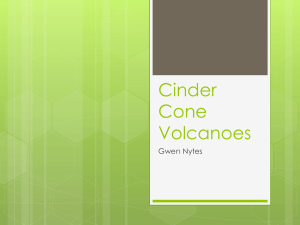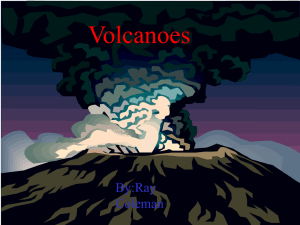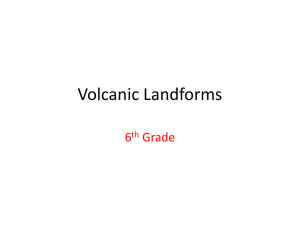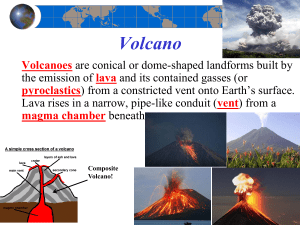Volcanoes - Schmidtclass
advertisement
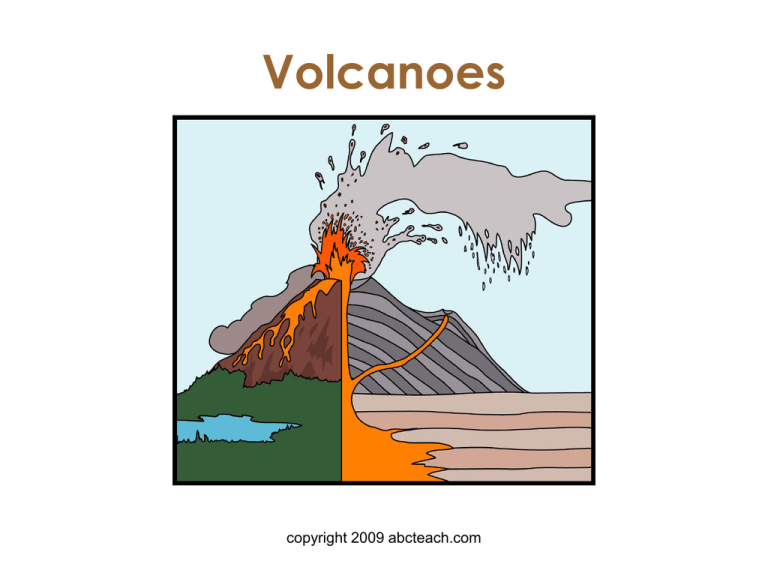
Volcanoes copyright 2009 abcteach.com Volcano Diagram copyright 2009 abcteach.com Types of Volcanoes Geologists (scientists that study rocks and Earth) divide volcanoes into four main types: cinder cones, composite volcanoes, shield volcanoes, and lava domes. copyright 2009 abcteach.com Cinder Cones Cinder cones are the simplest kind of volcano. They are built around a single vent, or opening. After lava and hot gases are blown into the air, they cool and fall back down to Earth as cinders. These cinders gather around the vent and form a cone with a crater in the middle. Cinder cones are often found on the sides of composite volcanoes, shield volcanoes, and calderas. copyright 2009 abcteach.com Composite Volcanoes Composite volcanoes are sometimes called stratovolcanoes. Like cinder cones, most composite volcanoes have a crater at the top, with a central vent or a cluster of vents. When lava erupts from the vent, it flows down the side of the volcano through breaks in the crater or through cracks in the side of the volcano. The volcano gets bigger as lava, cinder, and ash are added to the slopes. copyright 2009 abcteach.com Composite Volcanoes Among the most famous composite volcanoes are: • Mount Fuji in Japan • Mount Cotopaxi in Ecuador • Mount St. Helens in Washington • Mount Rainier in Washington copyright 2009 abcteach.com Composite Volcanoes: Caldera Sometimes large amounts of lava can erupt very quickly. When this happens, empty spaces in the ground below the volcano form and the volcano can no longer be supported. Without support, the volcano collapses and forms a deep bowl-shaped hole in the ground, called a caldera. Crater Lake in the United States is a caldera that has filled with water. After the collapse of the volcano, before the caldera filled with water, a final bit of volcanic activity produced a cinder cone on the side of the caldera. This cinder cone is now Wizard Island in Crater Lake. copyright 2009 abcteach.com Shield Volcanoes Shield volcanoes are built almost entirely from lava flow. Lava flows out of the central vent or group of vents and flows downward across the ground. As the volcano grows, it begins to look like a warrior’s shield, which is how this type of volcano got its name. After thousands of lava flows, the volcano can become very big. The biggest shield volcano, in fact the world’s biggest active volcano, is Mount Loa in Hawaii. From the floor of the ocean to the top of Mount Loa is over 28,000 feet! copyright 2009 abcteach.com Lava Domes Lava domes usually form in the crater or on the sides of large composite volcanoes. The domes form when very thick lava is ejected from a vent or crack. The lava is too thick to flow very far, and just begins to harden around the vent. Lava domes grow from the inside. The outer layer of lava cools and hardens, but as more lava is ejected from the vent, the outer layers crack and crumble down the sides of the dome. copyright 2009 abcteach.com Questions 1. What are the four types of volcanoes? 2. How do cinder cones form? 3. What type of volcano is Mount St. Helens an example of? 4. What is a caldera? 5. How do shield volcanoes form? 6. What forms when the lava is too thick to flow? copyright 2009 abcteach.com Answers ANSWERS TO TYPES OF VOLCANOES The four main types of volcanoes are: cinder cones, composite volcanoes, shield volcanoes and lava domes. 1. Cinder cones form when hot lava and gases are blown into the air, and then cool and fall back to Earth as cinders. The cinders gather around the vent and form a cone with a crater on top. 2. Mount St. Helens is an example of a composite volcano. 3. A caldera is the bowl-shaped hole left in the ground after a volcano has collapsed. Crater Lake is an example of a caldera. . 4. Shield volcanoes form almost entirely because of lava flows. Lava flows out of a central vent or collection of vents and out over the ground. The lava cools in thin Sheets. After thousands of lava flows, the volcano can grow quite large. 5. A lava dome forms when the lava ejected is too thick to flow. copyright 2009 abcteach.com Related Materials Please Note: Links open in Slide Show. If you are in edit/creating mode you will need to “right click” the links below. Select “Open Hyperlink”. Types of Volcanoes: Reading Comprehension Volcano Labeled Diagram Volcanoes KWL Additional Activities and Worksheets *** (Matches PowerPoint) Microsoft Office may display a default warning about downloading materials. The above links are from abcteach.com and are safe. PERMISSON: This PowerPoint is for home, classroom, or school use only. It cannot be distributed, placed on a website, or duplicated for commercial use. For additional permission please contact support@abcteach.com. copyright 2009 abcteach.com



